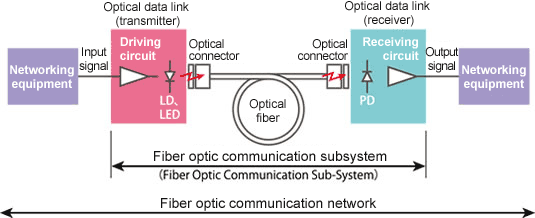- Related articles
- Cisco XFP vs. SFP vs. SFP+
- Optical Transceivers for Cisco ME-3400-24TS-D Switch
- What is 10Gb Network Card?
- Optical Transceivers for Cisco SG350XG-48T-K9-UK Switch
- Optical Transceivers for Cisco SG350-28-K9-UK Switch
- How to troubleshoot when network card stops working?
- All Cisco X2-10GB-ZR's information (List price, Specs, Datasheet PDF, Compatibility matrix
- How to check NIC card?
- What is CSFP transceiver?
- All Cisco 15454-GBIC-LX's information (Specs, Datasheet PDF, Compatibility matrix)

The current fiber optic communication technology is not only able to meet the demands for domestic network building but also stepping to the construction of international communication network. Fiber optic communication has developed so fast in recent decades because it is based on the optical fibers which give it many features or benefits as below.

1) Broadband information capacity is great. The optical fiber communication capacity is large, and the transmission width of the optical fiber is much larger than that of the cable or the copper wire. However, for the single wavelength optical fiber system, the terminal equipment is greatly limited, and the advantages of optical fiber transmission width can’t be used. So there is the need for scientific technology to increase the transmission capacity.
2) low loss, long distance transmission. Optical fiber communication loss rate is much lower than the ordinary communication loss rate. Optical fiber is not only low loss, but also can be used for long-distance communication, the longest distance for communication so far can reach more than 10,000 meters, so the optical fiber communication is more practical for the places where the demands for social networks and information are high. What’s more, optical fiber communication is highly cost-effective, as well as with good security.
3) Strong resistance to electromagnetic interference. Optical fiber is an insulator material mainly made of quartz as a raw material, this material is good insulation, and not easy to be corroded. The most important feature of optical fiber communication is the strong anti-electromagnetic interference ability, and free from interferences of the natural sunspot activity, ionospheric changes, and lightning as well as the artificial electromagnetic interference. Besides, fiber-optic communication can also be combined with the power conductor to form a composite optical cable or parallelly erected with the high-voltage wire, which is a great feature that makes a great effect on the communication system of strong power filed. Optical intensity communication can be applied to the military because it can be free from the interference of the electromagnetic pulse.
4) Good security and confidentiality. In the transmission of the conventional radio wave, there was a phenomenon in which the electromagnetic wave was leaked during the transmission process, so that interference happened to the various transmission systems and the confidentiality is not good. However, optical fiber communication transmits the signal mainly by the light waves, the optical signal is completely limited in the structure of the optical waveguide, and other leaked rays will be absorbed by the foreskin outside the fiber line, even in the bad ring or the corner, there is a little light leak. And in the process of optical fiber communication, a fiber optic cable can include lots of optical fibers inside, and they will not interfere with each other. Therefore, the optical fiber communication has a strong anti-jamming capability and confidentiality, and the security performance is very high.
Conclusion
In addition to the specific features above, there are many more advantages with optical fiber communication, like low-cost raw materials of fiber, rich resources, soft fiber, light weight, easy to lay, and long life, good stability. And fiber communication can be widely used not only in power communications but also in industrial and military applications as well as in other fields.





































































